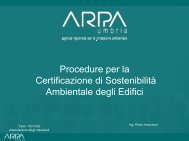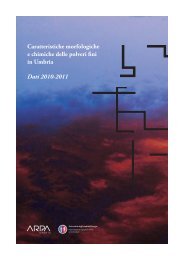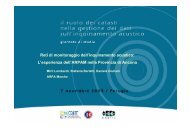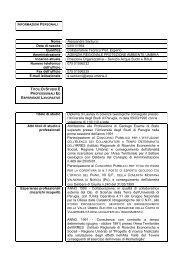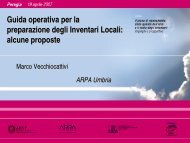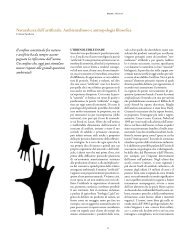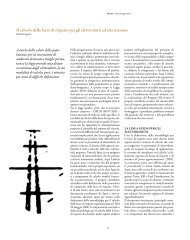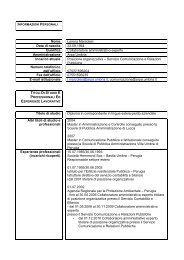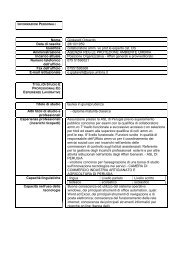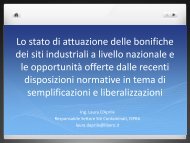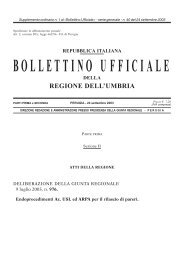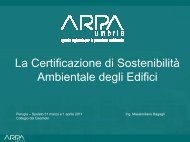Tutela ambientale del Lago Trasimeno - ARPA Umbria
Tutela ambientale del Lago Trasimeno - ARPA Umbria
Tutela ambientale del Lago Trasimeno - ARPA Umbria
Create successful ePaper yourself
Turn your PDF publications into a flip-book with our unique Google optimized e-Paper software.
2 0 4 A r p a U m b r i a 2 0 1 2<br />
<strong>del</strong>le specie esotiche più abbondanti o<br />
mediante azioni indirette di manipolazione<br />
<strong>del</strong>le catene alimentari. Fondamentale<br />
per raggiungere tali obiettivi è<br />
la conoscenza degli stock ittici presenti<br />
nel lago ed il monitoraggio <strong>del</strong>lo sforzo<br />
pesca e <strong>del</strong> prelievo.<br />
Comunità importante e fondamentale<br />
per l’equilibrio <strong>del</strong> lago, al pari<br />
<strong>del</strong>la fauna ittica, è quella <strong>del</strong>le macrofite<br />
sommerse radicate. Il loro ruolo è<br />
determinante per garantire la stabilizzazione<br />
ed ossigenazione dei sedimenti,<br />
il “seppellimento” <strong>del</strong> fosforo, la riossidazione<br />
<strong>del</strong> metano, l’allontanamento<br />
<strong>del</strong>l’azoto per denitrificazione.<br />
Tutto ciò porta alla conservazione<br />
o al recupero qualitativo di un lago<br />
piatto, condizione tipicamente rappresentata<br />
da un lago ad acque limpide, in<br />
contrasto con lo stato torbido dominato<br />
dal fitoplancton e dalla circolazione di<br />
sedimenti.<br />
Favorendo la minimizzazione dei carichi<br />
esterni, di origine civile, industriale<br />
ed agro-zootecnica, nonché il trasporto<br />
dei sedimenti dalla rete dei fossi/canali,<br />
il controllo dei carichi interni, connessi<br />
alla biomassa ed ai sedimenti, può essere<br />
attuato con una gestione ecocompatibile<br />
<strong>del</strong>la zona umida costiera e con interventi<br />
di biomanipolazione per il riequilibrio<br />
<strong>del</strong>la vegetazione sommersa (reimpianti,<br />
enclusures).<br />
Particolare attenzione deve essere<br />
posta ad evitare effetti nefasti dovuti al<br />
dragaggio dei sedimenti, al taglio sistematico<br />
<strong>del</strong>la vegetazione acquatica e <strong>del</strong><br />
canneto in acqua.<br />
Un cambio di approccio culturale<br />
al problema favorirà il raggiungimento<br />
<strong>del</strong> buono stato <strong>ambientale</strong>: conoscenza,<br />
studio e partecipazione pubblica<br />
sono le basi per valutazioni e scelte alla<br />
base di un piano di gestione integrato<br />
a tutela <strong>del</strong> bacino lacustre e <strong>del</strong>le sue<br />
popolazioni.<br />
lances. It can have a direct effect, when<br />
the most abundant exotic species are<br />
fished, or indirect, when the trophic<br />
chains are manipulated. To this end it<br />
is essential to have quantitative information<br />
on the fish resource and to monitor<br />
the fishing activity and catches.<br />
An important community, and fundamental,<br />
along with fish fauna, for the<br />
balance of the lake, is the community of<br />
submerged rooted macrophytes. These<br />
have a fundamental role in guaranteeing<br />
the stabilization and oxidation of sediments,<br />
the “burial” of phosphorus, the<br />
re-oxidation of methane, and the removal<br />
of nitrogen due to denitrification.<br />
All this leads to the conservation of<br />
and improvement in the quality of a flat<br />
lake, a typical sign being clear waters,<br />
as opposed to the turbid waters dominated<br />
by phytoplankton and sediment<br />
circulation.<br />
By reducing to a minimum the external<br />
loads of civil, agricultural and livestock<br />
origin, as well as the transport of<br />
sediments from the network of ditches<br />
and channels, the internal load, linked<br />
to the biomass and the sediments, can<br />
be controlled, through eco-friendly<br />
management of the wet coastal zone and<br />
biomanipulation to restore balance in<br />
the submerged vegetation. (transplants,<br />
enclosures).<br />
Particular attention must be placed<br />
on avoiding negative effects due to dredging<br />
of sediments, and the systematic<br />
cutting of aquatic vegetation and reeds<br />
in the water.<br />
A change in the cultural approach<br />
to the problem would favour achieving<br />
a good environmental state for the lake.<br />
Information, research and involvement<br />
of the public are the basis for assessments<br />
and choices on which to construct<br />
an integrated management plan<br />
for the protection of the lake and its<br />
communities.



